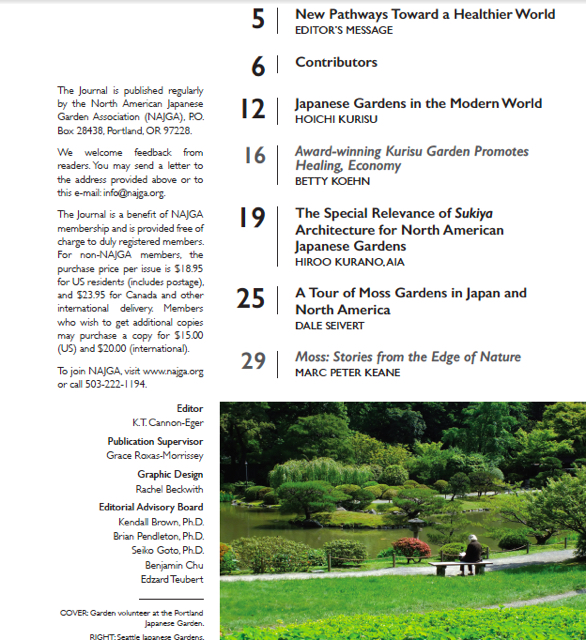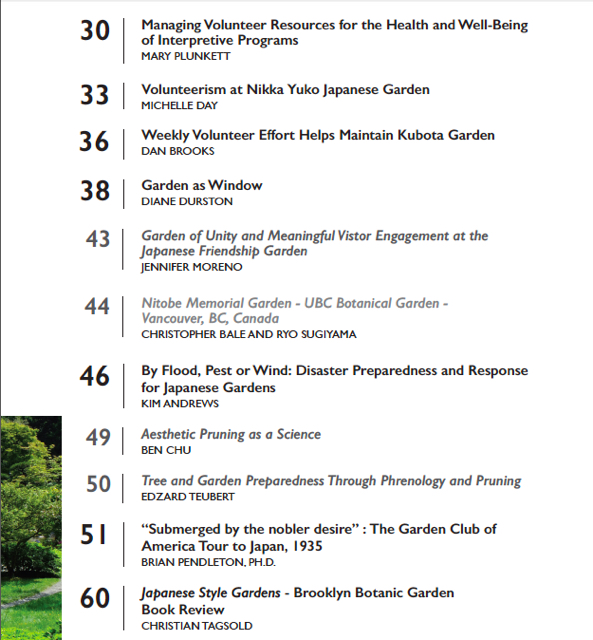
The third issue of The Journal of the North American Japanese Garden Association (NAJGA) is now available in print. The Journal is FREE to members and also available for purchase by members who wish to get additional copies and to the general public.
Member Price: $16.00 (within US), $20.00 (Canada, Japan and other countries) General Public: $20.00 (within US), $25.00 (Canada, Japan and other countries). Prices include postage. To order, send an e-mail to info@najga.org.
From NAJGA Journal 3 Editor K.T. Cannon-Eger:
EDITOR’S MESSAGE: New Pathways Toward a Healthier World
“The first issue of the Journal of the North American Japanese Garden Association concentrated on “Connections,” the theme of the first biennial convention held in Denver in 2012. Journal two was organized around the theme of “Lessons Learned.” Following the 2014 biennial convention in Chicago, Illinois, and with an eye toward the 2016 conference in Delray Beach Florida, this issue was organized around the theme of “New Pathways Toward a Healthier World.”
The initial hope of the first Journal to encourage landscape specialists and enthusiasts to explore articles outside their immediate areas of interest continues in this issue while we maintain a dedication to the NAJGA goals of advancement in Horticulture, Human Culture, and Business Culture.
In horticulture, we draw on one of the stalwarts of NAJGA, a garden designer and gentle speaker on the benefits to human well-being of Japanese-style landscapes. His remarks are followed by a case study of a hospital in Oregon. Delving further into horticulture, is an article on moss and its uses in gardens in Japan and around the world. This is accompanied by an excerpt from a new book of short stories, one of which speaks to remediation by moss.
Connecting several gardens is the human culture question of how gardens attract volunteers, how the volunteers are trained, and how their interest is maintained.
The business culture portion of this issue tackles two subjects. First, how do public gardens attract visitors and maintain their interest? Second, how do public gardens prepare to handle crises such as fire, flood, or storm damage?
Articles of historical interest, a book review, and obituaries round out the contents of Journal number three.
I am full of gratitude for the guidance and direction of the Board of Directors Past President and first Journal Editor Kendall H. Brown, whose knowledge and dedication are above and beyond. He has skillfully taken editorial scalpel to overly long manuscripts. His artistic sensibility and devotion to history are among other great assets to the organization and to this Journal. This issue could not have happened without the work of the editorial board. Thank you Dr. Seiko Goto, Ben Chu, and Edzard Teubert. And a great big tip of the hat to Grace Roxas Morrissey of NAJGA who keeps us all on track. Deep gratitude to all the authors, photographers, and graphic artists who have contributed their talents. Readers will find more information about the authors on a subsequent page. Welcome to Brian Pendleton of Vancouver, B.C. who is taking on editorial responsibilities for the next issue.”
Here’s a look at the Table of Contents:








